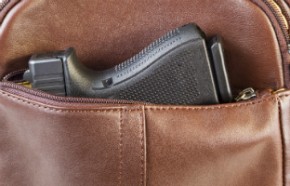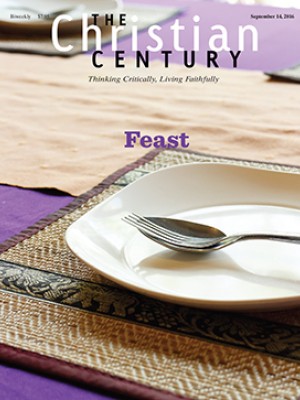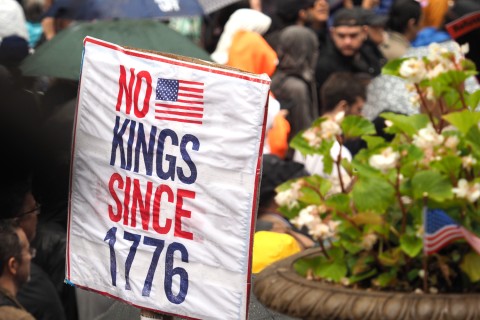
Lately I’ve been noticing bumper stickers designed in the shape of the state of Connecticut, with a gun silhouette, the letters CCDL (Connecticut Citizens Defense League, Inc.), and the statement, “Carry On!” I assume that the sticker is in support of the concealed and open carry laws and that its presence on a bumper means that the driver probably has a gun.
Thank you, bumper sticker, I say to myself, for warning me that this driver has a gun in the car. It’s a clever move to keep people away. A bully move that works. I realize that I’m avoiding eye contact with the driver at the stoplight. After all, who wants to piss off the guy with a gun in his car?
Read our latest issue or browse back issues.
As it turns out, a lot of people have guns in their cars or guns in their briefcase or handbag or tucked in their coat—all “safely” concealed. Thirteen million people.
Our friends advise us, “Don’t dial drunk.” Don’t pick up a phone and call your ex, for example, when you’re in an emotionally altered state derived from alcohol. Yet now all 50 states have concealed carry permits, enabling us to carry guns through all the emotional highs and lows that any day brings. Thirteen million people are carrying concealed weapons, including people in line at Dunkin’ Donuts, people lounging at the city pool, and people playing at the miniature golf course—some of whom will lose their tempers when another golfing group jumps ahead of them on the course. People have guns in their cars during moments of road rage and even at the DMV, where tempers flare after waiting in line for an hour just to update a license. The 13 million people with a license for concealed carry represent more than 12 times the number of police in the United States.
When I pastored a church, I learned how emotionally volatile we humans are. Most of us can’t always keep ourselves together. This is not a diagnosis of some particular mental health issue but rather an expression of a human reality. There is some “snap” that happens in a day or a week or over the year, some break in our sense of knowing how we fit in this world that causes us to act in ways that are against our well-being. Mostly we numb the pain with one of the many forms of distraction easily available to us, but there is often anger just beneath the surface, and some of us are more prone than others to expressing our anger outwardly. Now having a gun with us at all times is as easy as having a bottle of wine in the fridge. Easy access to a fatal weapon seems inadvisable to me, a move made because we think we are different than we really are. Add to that the fact that we are living in intensely uncertain times.
In an interview on the public radio program Fresh Air, reporter Evan Osnos described the fear expressed by people who carry concealed weapons. They “talk about this immense sense of insecurity, both physical insecurity from the idea of a mass shooting but also more broadly . . . an economic insecurity, the idea that the professions and businesses that they used to have have fallen away. . . . And also political insecurity—they feel as if their voice is no longer represented by mainstream politicians.”
The rise of concealed carry is about safety, self-protection, and security. It’s an expression of an instinct that drives a person who feels, as Osnos says, “as if I am losing power, and . . . as if one of the ways in which I can fortify myself is by buying a gun.” Even if we don’t own a gun, we are represented by state legislatures that agree that carrying a gun provides the safety and security we seek.
Here’s the thing, though: we aren’t safe. We aren’t secure. We don’t act in accordance with the rules of reason all the time. We flip out. We dial drunk. When we are not as we wish we were, or things are not going as we wish they would, we do things that are not in our best interest or in the interest of our neighbors. Carrying a gun or bringing one into our homes actually creates more insecurity: “The simple fact is, by bringing it into your life, by bringing it into your home, you significantly raise the risk of suicide, of homicide, of accidental gun death. The chances of a homicide of some kind doubles,” says Osnos.
Some may argue that the “Who wants to piss off a guy with a gun?” line of thinking justifies having a gun. I argue that the effect of this kind of thinking is not safety but the opposite—increased systematic isolation and anxiety.
Scholar and author Jennifer Michael Hecht writes on suicide in her book Stay: A History of Suicide and the Philosophies against It. She speaks against suicide by alerting us to our essential need for each other. “We are indebted to one another and the debt is a kind of faith—a beautiful, difficult, strange faith. We believe each other into being.”
We are so in need of one another that our isolation from one another, our being or feeling alone, kills us. It makes us kill ourselves. It causes us to kill others.
We aspire to feel safe and secure in our lives, but the feeling and fact of safety is always only temporary because it exists within a context that we share: we are here now but one day we will die. In that wide view, the most fundamental form of safety we can offer one another is one another. Laws, policies, community, family, and personal practices that help us to connect with one another in the midst of the nagging uncertainties of our lives are the best avenue toward a resilient security.
Concealed carry, which has put more guns into more hands, purses, and cars, is a fallacy of safety. Guns add tension. They introduce more walls between us. If the gun doesn’t kill us, the walls that are going up between us will.
A version of this article appears in the September 14 print edition under the title “More guns, more fear.”






